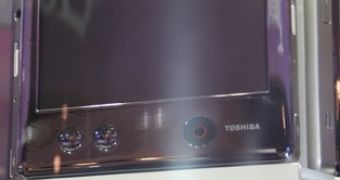Toshiba was quite impressive during this year's Consumer Electronics Show that has just ended. It touted a new tablet PC, the M700, as well as a wide offering of notebooks, but the most impressive of its products were the showcased ultra-mobile PCs. Although their small slate-like devices are in their early days, they managed to stay in the spotlight during the CES.
Toshiba's UMPC device bears no distinct name and it is highly unlikely for it to make it onto a store shelf. However, in the event that it gets released, it will be one of the most portable devices of its kind. It includes a set of new features that make it special among the other UMPCs on the market.
Its small size is its strongest point, but other worth mentioning features include a 1.8-inch hard disk drive to store 80 GB (optionally, it can be changed with a 64/128 GB SSD), a 5.6″, touch screen, and an SD reader. As for the connectivity, the built-in radio options include Wi-Fi, Bluetooth, 3G, and Wi-Max.
The system does not include a "flesh and bones" keyboard option, and user data can be entered using a virtual on-screen keyboard. While displayed, the virtual keypad would cover most of the workspace, but the main image shrinks down and the text field stays visible, so you can still see your actual input.
The whole system is built on top of the Intel Menlow platform, which marks an end to the old McCaslin era. Powered by a 45-nanometer Silverthorne processor, it will ensure a prolonged battery life at no performance compromise.
One of the model's shortcomings is the fact that it does not come with a fully-fledged (even though miniaturized) keyboard. Toshiba's UMPC may be small, but the Silverthorne heart allows it to run Vista relatively well. However, Vista seems to be less appealing than the Linux-based, eye candy operating systems that will accompany the soon-to-come MIDs.

 14 DAY TRIAL //
14 DAY TRIAL //